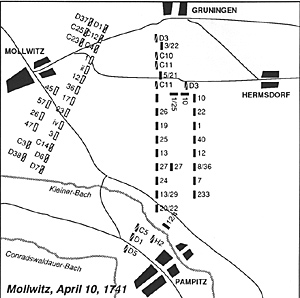
The Prussians were rousted from their quarters at dawn on April 10, 1741 and were greeted by a clear sky, crisp air, and a new blanket of snow from the previous day's blizzard. They formed into five march columns and left their knapsacks with the baggage wagons so that they would be ready for battle, if necessary. Colonel Rothenburg's advance guard of seven squadrons of cavalry rode ahead to clear the way, and they chased a few Austrian hussars out of the village of Neudorf, a short distance from Mollwitz.
Prisoners and local peasants informed Frederick that the Austrians were dispersed around three villages to their front: Mollwitz, Gruningen and Hunern, all within sight of the church spires of Brieg. By 10 A.M. the Prussians were on the march, but their progress was slowed by the passage of concealed ditch,the Neungraben, then by the need to funnel through the defile through the Kreisewitz Forest in front of Neudorf.
Meanwhile, in the Austrian camp, Neipperg's dinner was disrupted by the sounds of gun fire coming from the direction of Neudorf. Breathless scouts warned him of the approaching Prussian columns, while simultaneously, lookouts in the Brieg church tower fired rockets to warn the Austrians in Mollwitz. Neipperg had expected the impending battle to come from the northwest of his position, but now scouts advised him that the enemy were coming from the southeast of Mollwitz. According to deployment conventions of the period, units were previously designated to be in the front or rear line of the army's battle formation and were also expecting to be either on the left or right flank of the line. Considerable confusion overtook the Austrian infantry as units designated to the right flank the night before now found themselves ordered to take positions on the left , and visa versa.
Consequently, the Austrian infantry deployment was slow in developing and presented a wonderful target for an aggressive Prussian army. Fortunately though, the Prussians were experiencing considerable deployment problems of their own, and their advance on Mollwitz was delayed for some time.
On the Austrian left, General Romer's cavalry brigade of 30 squadrons (4500 men) had deployed around a lone windmill and hoped to buy some time for the Austrian infantry formation, should the Prussians advance too soon. Eventually, a ragged and somewhat disordered line of infantry assembled in front of Mollwitz, with Romer's cavalry on their left, and a small brook and Berlichingen's brigade of cavalry protecting their right. The Austrian artillery, however, was still working its way to the front.
The Prussian deployment hardly fared any better. Frederick had layed out boundaries and positions for the army: the left flank was to rest on the same brook used by the Austrians (northwest of Neudorf) and was to extend some 3000 paces to the west and anchor the right flank on the woods in front of the village of Hermsdorf. The Prussian march columns advance onto the field with parade ground precision and made a right angle turn whereupon they would deploy into two lines, 250 paces apart. A problem occurred when Schulenburg's cavalry brigade misjudged the distances on the battlefield and failed to advance far enough to their right, thereby cutting nearly 800 paces off of the intended battle frontage.
Christopher Duffy describes the result best:
- "A number of units found themselves without a home--namely a grenadier battalion of the second column, two regiments and one battalion of infantry of the fourth column, and the whole of the battalions of the fifth column--and they all had to be fitted in haphazardly along or between the lines of battle."
- (from The Military Life of Frederick the Great, page 31)
As a makeshift solution, three of the grenadier battalions deployed between the two Prussian lines, facing northwest, so that the Prussian formation now resembled a large rectangle with supporting cavalry on both flanks. Schulenburg realized his error and attempted to compensate for it by extending his line to the right past Hermsdorf. This involved a wheel to the right in column, which exposed the cavalry's flank to the Austrians. At the same time, two grenadier battalions were interspersed with the dragoons for support. Over on the left flank, frontage problems forced Posadowsky's brigade of cavalry to deploy on the opposite side of the small brook, cutting them off from the rest of the Prussian army.
Battle of Mollwitz: April 10, 1741
-
Background and Austrian Counter-Attack
The Action Begins
The Austrian Cavalry Charge
Momentum Swings to the Prussians
Order of Battle and Wargaming Mollwitz
Back to Seven Years War Asso. Journal Vol. VI No. 1 Table of Contents
Back to Seven Years War Asso. Journal List of Issues
Back to Master Magazine List
© Copyright 1992 by James J. Mitchell
This article appears in MagWeb.com (Magazine Web) on the Internet World Wide Web.
Other articles from military history and related magazines are available at http://www.magweb.com